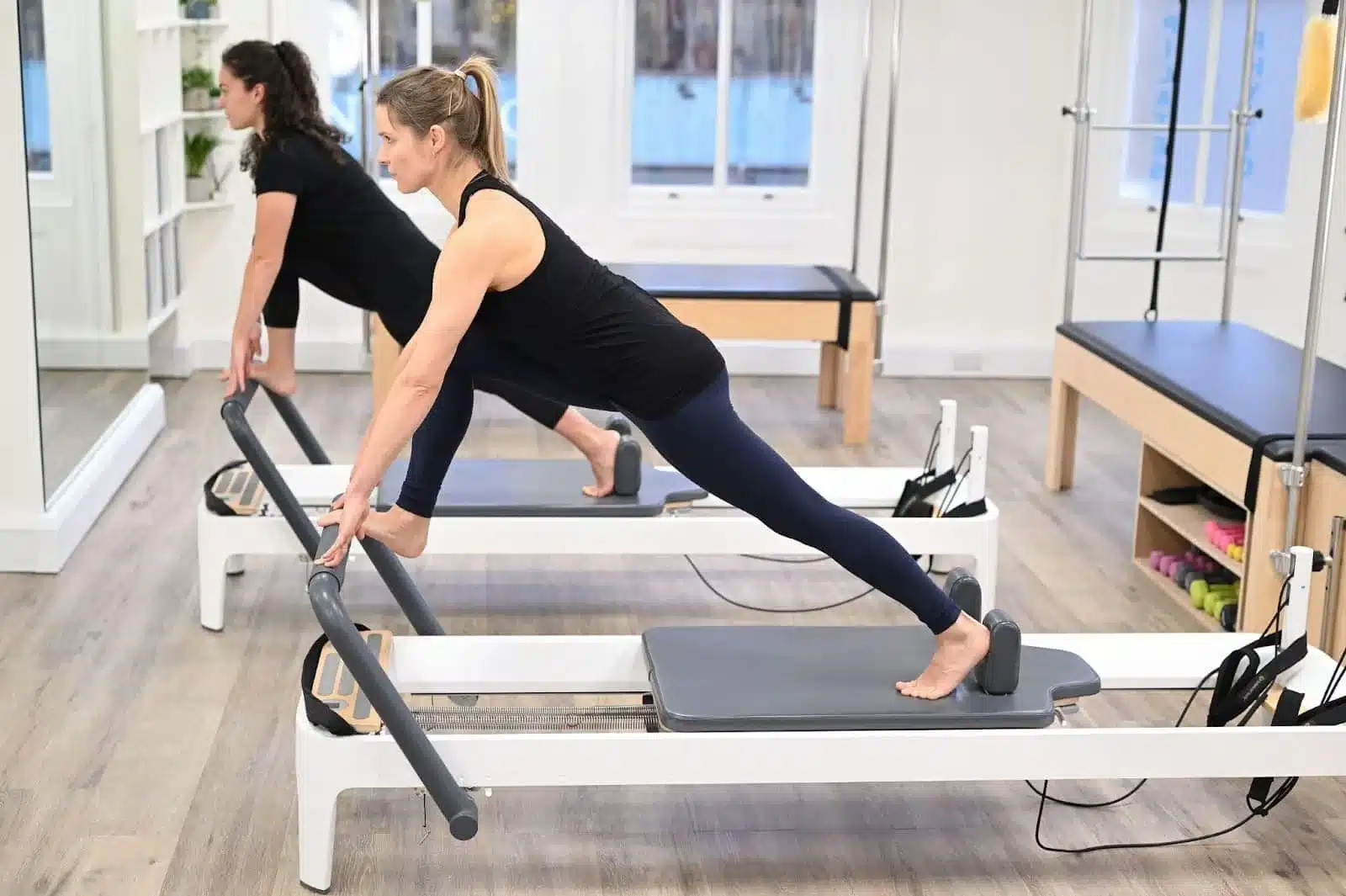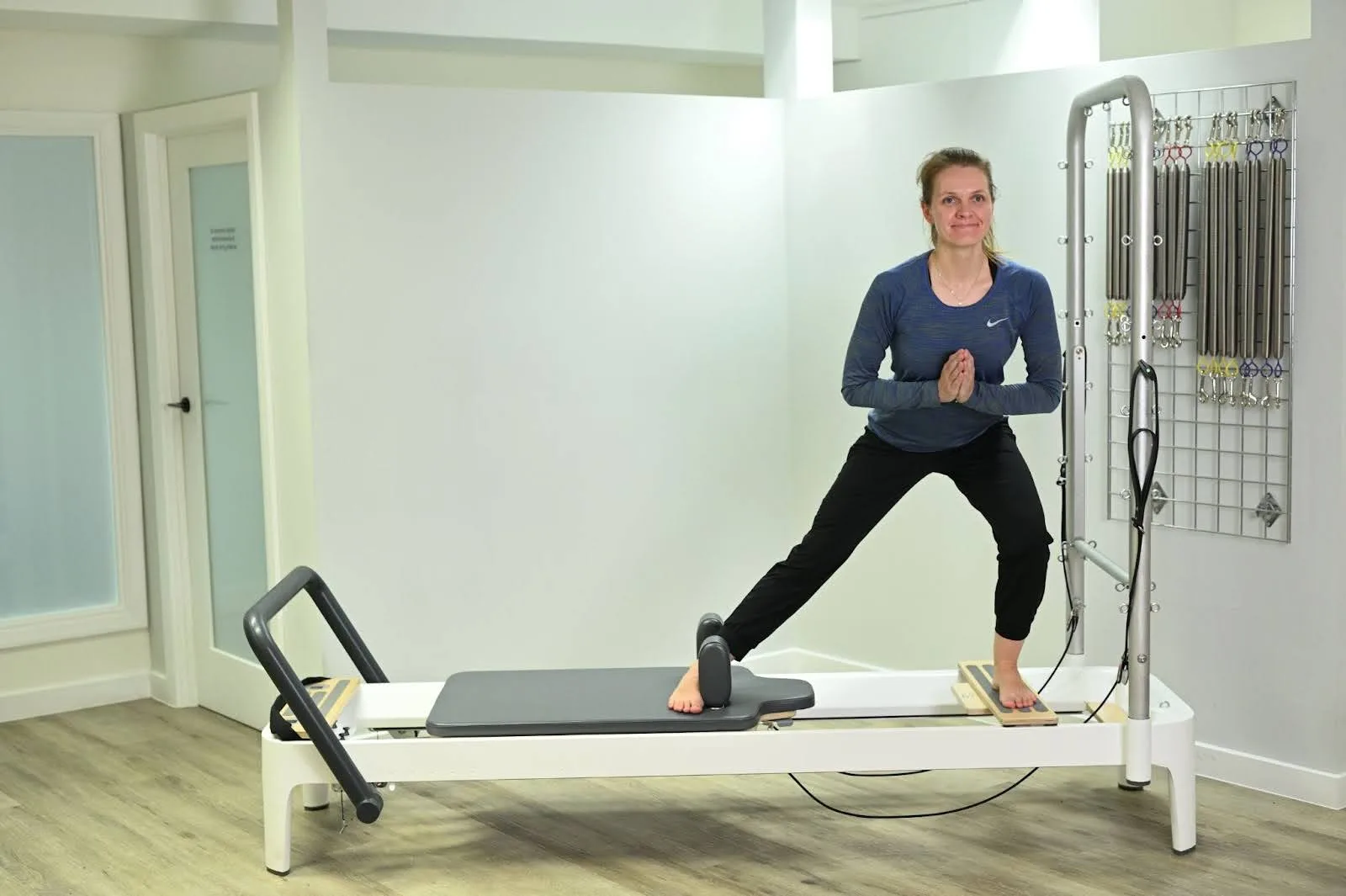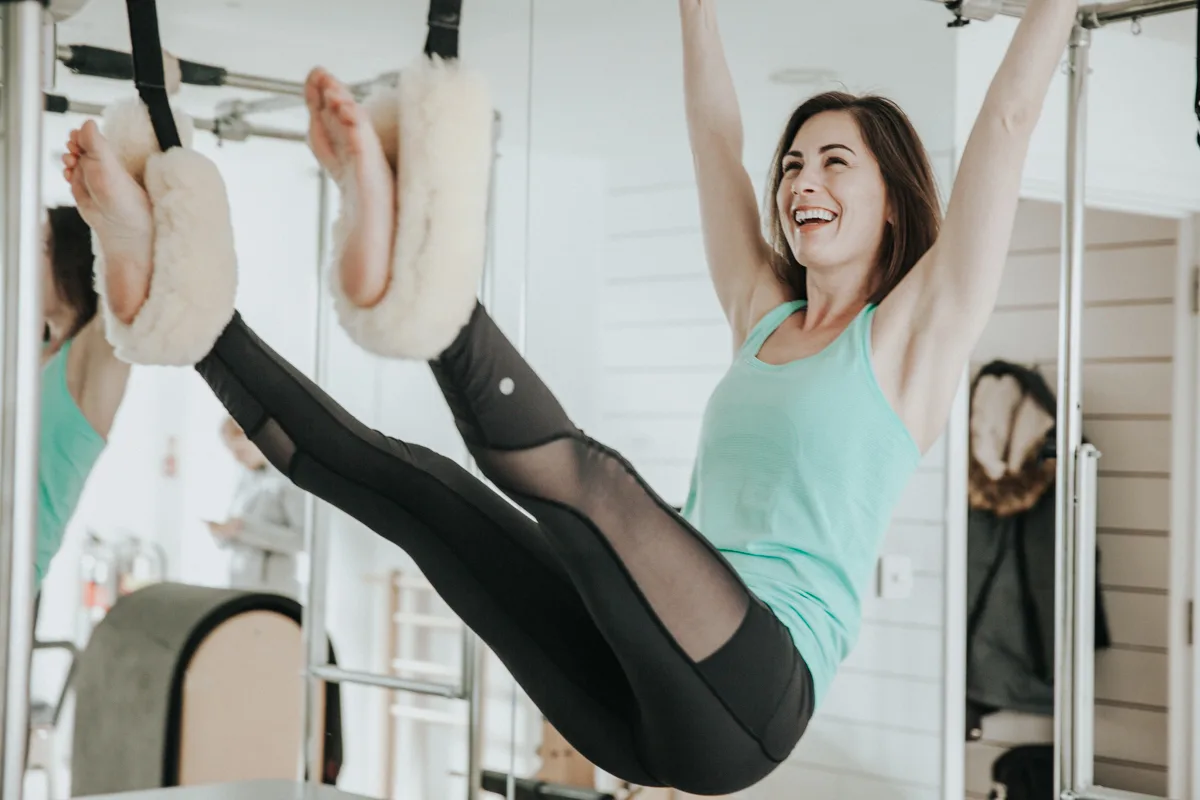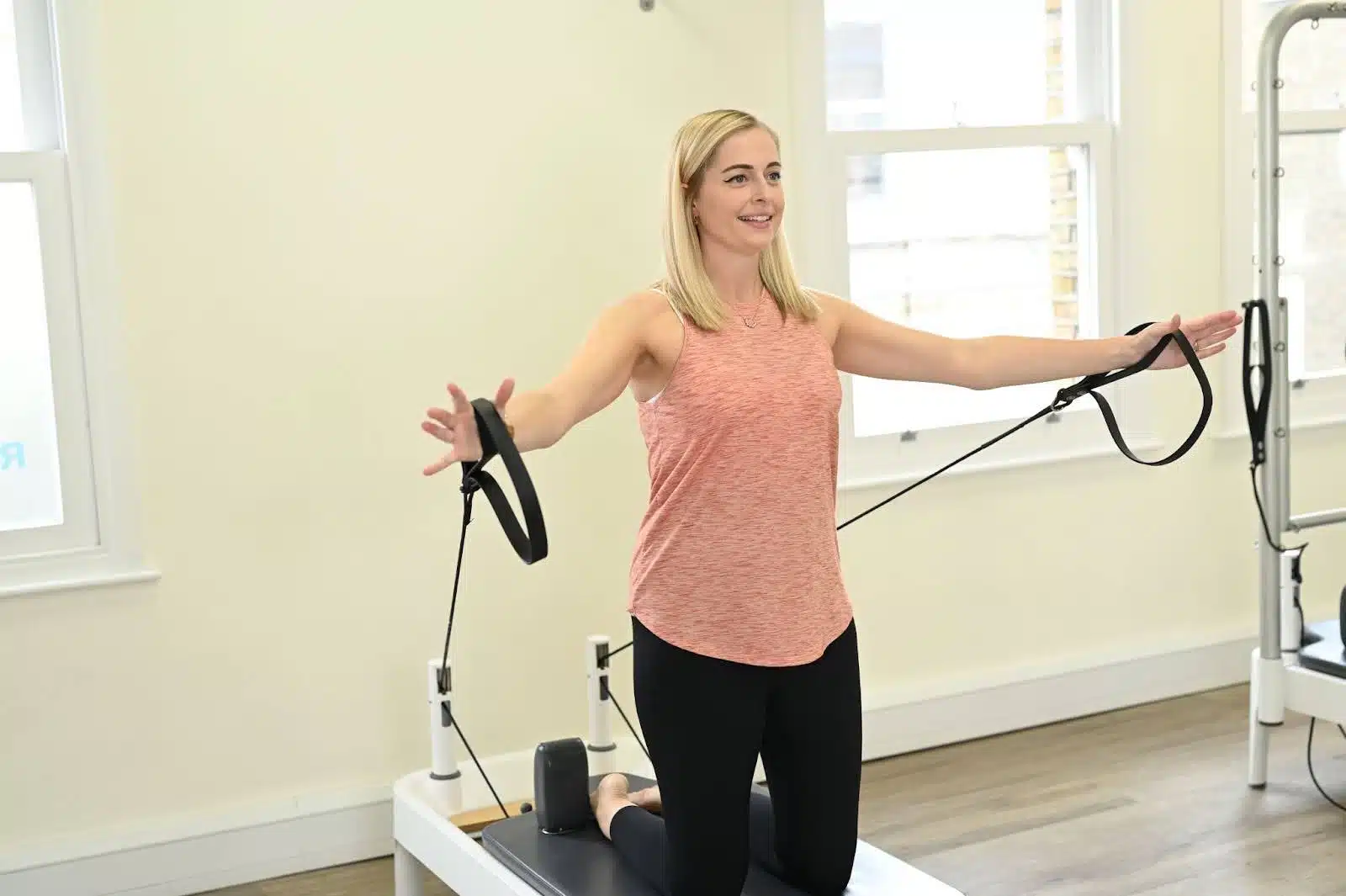Key Contributor: Susie Martin, Chartered Physiotherapist
Introduction
Pilates in general is experiencing something of a boom at the moment due, in part, to the popularity of reformer Pilates.
In turn, reformer Pilates is gaining a reputation for the unique ways that it can change your body, since it is so popular and unlike other forms of exercise.
Practicing reformer Pilates can help you improve your all over body strength, flexibility, body awareness, balance and coordination. Not only that, but for some, it may even create noticeable external changes that reflect your changing strength and body awareness, such as more definition in your muscles and improving posture.
Key Takeaways
- Reformer Pilates will help you strengthen your body all over, and is particularly good for helping you work on abdominal and trunk strength. It will also help you improve mobility and flexibility.
- Reformer Pilates may help change your body aesthetic only as part of an overall programme that should take into account nutrition and balanced exercise, including strength training and cardiovascular exercise.
- Beware of ‘before and after’ photos making unsubstantiated claims about what you can achieve with reformer Pilates alone.
Real-life before and after Pilates photos
Whilst we’d love to be able to show you “Before” and “After” Pilates photos, the truth is, these types of images can easily be manipulated and don’t necessarily reflect real life. We don’t believe in making false claims about what Pilates can do for you and the reality is that every body will respond differently to reformer Pilates, and other types of exercise may be necessary if you are looking for a specific aesthetic.
As a physiotherapy led Pilates studio, our primary focus is on health and function, rather than aesthetics. We believe in promoting realistic ideas about what a fit and healthy body is. We measure progress not by what you look like, but what you can do.
However, given our passion for Pilates and how fun it is, we think that before and after reformer Pilates photos generally look a bit like this…..

You may experience differences in the way your body looks and feels before and after reformer Pilates, but this is a byproduct of what you do rather than our main aim. There are lots of wonderful benefits to practicing reformer Pilates, so don’t despair – keep reading to find out all the reasons why reformer Pilates is brilliant for you!
What Changes can I expect with Reformer Pilates?
Changes you can expect with reformer Pilates:
All over body strength
Reformer Pilates has a unique way of targeting the whole body, which feels very different to other types of strength training. In particular Pilates is able to help you target the deep abdominal and spinal muscles that are commonly thought of as ‘the core’.
The ‘core’ comprises many different muscles extending from your ribcage down to your knees, including the deep abdominals, deep spinal muscles,the lateral hip muscles, the pelvic floor muscles and the inner thigh muscles, among others.
Having a strong core doesn’t just mean having ‘abs’, it includes many more muscles and isn’t just about how your body looks, but about how well your body functions.
Having a strong ‘core’ means that you can distribute workload equally among different muscle groups in the body, for example, when carrying, lifting, pushing or pulling. It also means that you can transfer force from the lower body to the upper body – for example during throwing or racquet sports.
This can help to distribute stress and strain throughout the body – making it less likely that you injure one part of the body which is being overloaded.
Improved mobility
Reformer Pilates, as with other types of Pilates, has many exercises that target flexibility and mobility. The spine needs to be able to move in a combination of six different directions – rotation, side bending, forward and backward bending. In day to day activities, we often don’t use the full mobility of the spine, especially backward bending.
Exercises such as the Swan on the reformer help you work on your backward range of motion, whereas the Mermaid variations target side bending.
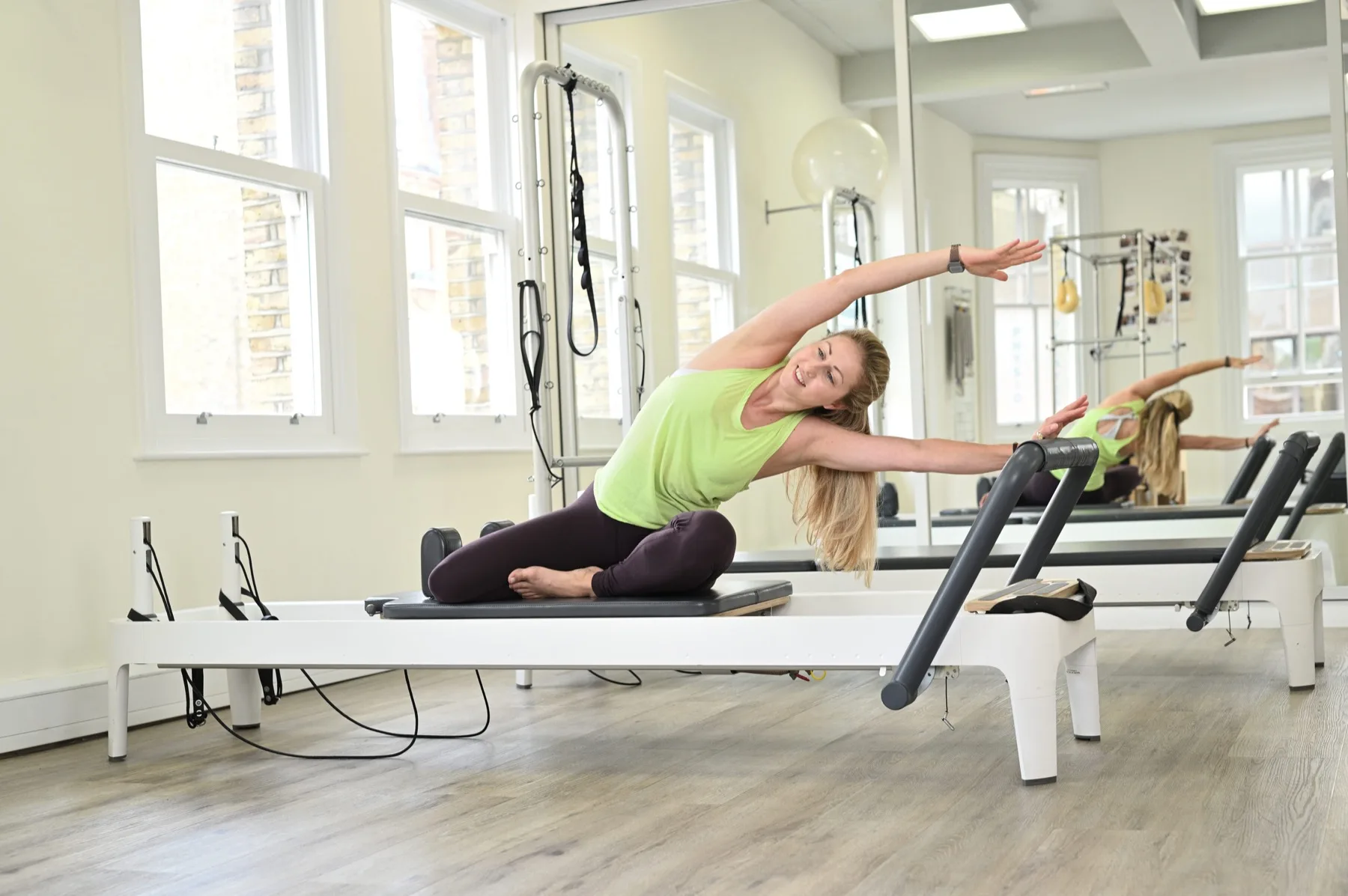
Other exercises such as “Feet In Straps” and “Standing Hip Stretch” can help to improve flexibility in the hamstrings and hip flexor muscles.
Reduced pain and stiffness
Our bodies are built for movement, and we often experience aches and pains, or sensations of stiffness related to lack of movement.
This is because with sustained positions we start to get a reduction in blood flow to muscles, and joints are lubricated by the fluid inside when we move. Moving regularly maintains blood flow to muscles, maintains mobility within soft tissues and maintains lubrication in the joints.
Injury Recovery
Reformer Pilates is brilliant for helping you to continue moving and challenging your body whilst you recover from an injury. It is common to stop exercising after an injury, and this often means a loss of strength and mobility, not only around the injury but all over the body.
Pilates can exercise different muscle groups, and be adapted to reduce the load on an injured area, or to work around it. On an ongoing basis, improving your movement patterns through Pilates can help you prevent future injuries and provide the foundation for ongoing strength and conditioning exercise.
Read more about Pilates for injury recovery.
Improved body awareness
Pilates taught well, should have an emphasis on the connection between mind and body. Focussing on the sensations of the body can help you to detect unnecessary tension which, unnoticed, can lead to straining and discomfort. Adjusting exercises to reduce tension leads to movement that feels much more easeful and fluid. Easy movement is often efficient movement that distributes workload evenly between different muscle groups.
Improved coordination
Whilst reformer Pilates is suitable for everyone because it has such a variety of exercises, some of the movement sequences can be quite complex, involving reciprocal movements.
This is great for your coordination and really stimulates the brain areas that co-ordinate movement as well as firing up neural pathways. Learning new movements is particularly stimulating for the brain!.
Improved sense of wellbeing
The combined effects of breathwork, strength and mobility, as well as low impact, flowing exercise, come together to give you a great sense of wellbeing. Many people say that they feel good after Pilates, in a way that they can’t recreate with other exercises.
Improved joint stability
One of the benefits of Pilates, particularly 1:1 Pilates, is the focus on attention to detail. Small adjustments in your movement enable you to work in a way that creates stability around the joints. This reduces unnecessary mechanical stress, which can be a cause of injuries such as muscle strains, tendon irritations and ligament sprain.
It also means that the large “global” muscles – responsible for movement, can function more efficiently, as they work from a stable base and are not trying to stabilise and move your joints at the same time.
Reformer Pilates Before and After Timeline
Whilst some may make bold claims about what Pilates can do to physically change your body, the reality is that a full body transformation may not be possible with only reformer Pilates. It is, in fact, dependent on multiple factors.
For weight loss – a combination of nutrition focussing on controlled intake, cardiovascular exercise and strength training is best. For muscle definition, a combination of very structured strength training and controlled nutrition is best.
Whilst Pilates has a deserved reputation for strengthening the abdominals, it won’t specifically help you to lose weight from your stomach as generally it is not possible to lose weight from specific areas of the body by exercising.
You can improve your muscle definition by reducing all over body fat, and increasing your lean muscle mass.
You may notice an improvement in your body shape through increasing the activity of the deep abdominal muscles and obliques, which act a little bit like a natural corset for the body. This ‘corset’ gently draws the stomach in and creates a waistline. It should not be trained to be rigid – you should be able to relax these muscles too. These muscles play a role in supporting the spine whilst still allowing freedom of movement.
You may also improve your appearance through developing greater awareness of your posture, standing with better posture generally has the effect of making you look slimmer.
Testimonials
“I’ve been having regular sessions for the past two months and the difference has been amazing. My posture has improved noticeably and I feel stronger, more balanced and energised.
“Each session is tailored to my needs and goals, there is such a supportive and positive environment. I always look forward to going and leave feeling great.
It’s been a brilliant investment in my health and I would highly recommend Complete to anyone thinking about starting Pilates.”
Google Review, Complete Pilates Chelsea, 5 Stars
“The support I’ve had from the team over the last few months has transformed my mobility and flexibility after many years of lower back pain. I can’t recommend Complete Pilates highly enough”
Google Review, Complete Pilates City, 5 Stars
“When looking for Reformer Pilates I was looking for a Physio-led program. I was suffering from recurring swim related injuries and needed strength to combat being in a desk job. I love Complete Pilates and their teachers!
My teacher has been amazing and so have all the others who I’ve had classes with. With their training I’ve become stronger, took my swimming to the next level and stopped having recurring shoulder injuries. I highly recommend Complete Pilates 💜 for making your body over!”
Google Review, Complete Pilates Angel, 5 Stars
Why changes are different for every body
Whilst there is certainly a lot you can do to improve the way your body looks and functions, ultimately there are reasons why some people may not be able to obtain the body they would like.
Unrealistic portrayals in the media
Magazines, television and social media all convey unrealistic ideas of what the average person looks like.
As physiotherapists and Pilates instructors we see real bodies every day, and so we understand that most people don’t look like the airbrushed or curated images that we are used to seeing in the media.
Genetics
Whether you are tall and slender, or short and more well built, may often come down to genetic tendencies.
Whilst we may believe that certain types of exercise may lead to certain body types – it may be more the case that certain body types may gravitate to those sorts of exercise because they are well suited to them.
For example – weightlifters tend to be shorter and more well built, whilst ballet dancers tend to have very long, slim legs.
Lifestyle
Being able to spend time on improving your body ultimately requires a time commitment particularly if you are chasing a certain ideal body type.
As we get older, work, families and other commitments may make it harder to devote as much time to improving your body as you would like.
A stressful lifestyle, or one where sleep is compromised or diet neglected, may make it also harder to achieve your physical goals, since your body is unable to build lean muscle tissue without adequate nutrition and rest.
Diet
If you are keen to lose weight or improve your lean muscle mass, simply exercising with no regard for your fuel, is unlikely to result in longer term, sustainable improvements. A balanced diet, with enough protein, fresh fruit and vegetables, and healthy fats is important for maintaining strength.
Consistency
In order to improve your body, a reasonable amount of consistency is necessary over a long period of time.
A chaotic lifestyle, or choosing to exercise every so often on a whim is unlikely to achieve the repetition that your nervous system needs to learn new movements and build strength.
Sleep
When undertaking any form of exercise – but especially higher intensity exercise – it is important to consider rest and recovery during your programme. It is a common misconception that when you are exerting yourself, that that is the time that is doing your body good.
However, particularly for strength training or when learning new movement e..g dancing, the adaptations that occur during your body happen during the periods after you have finished exercising.
When you are strength training, tiny microtears in the muscle occur during the activity, but it is the repair of those tiny tears in the muscle that builds stronger tissue. This happens during the recovery phase.
When you are learning a new movement, your body integrates your learning during periods of sleep – called “offline” learning. So you may often find you realise you have achieved a new skill, when you are no longer trying to do the skill.
Reformer Pilates vs Mat Pilates
Whilst mat Pilates is brilliant for learning the Pilates repertoire and can be done anywhere, Reformer Pilates has a lot more variation in terms of how you exercise the body and you can generally exercise against more resistance when doing reformer Pilates.
That said, there are a few great body weight exercises in mat Pilates, and weights can be added to challenge the movements more.
However you are potentially more likely to notice changes in your body more through doing reformer Pilates, especially if you have been doing mat Pilates for some time and your body has become accustomed to the same routine.
Read more: Reformer vs Mat Pilates
How to maximise your reformer Pilates results
- Practice reformer Pilates consistently over a long period of time. Popping into the odd reformer class when you get time can provide a novel change to your normal exercise routine but as with any exercise, a reasonable amount of consistency is needed to get better. Commit to doing this regularly for a period of at least 3 – 6 months, and you will notice more significant improvements.
- Practice Pilates frequently – 2 – 3 times per week. This could be a combination of reformer and mat work. As with the idea of consistency, practicing reformer Pilates frequently helps you to see more noticeable improvements and a lot faster. Read more: How often should I do reformer Pilates.
- If you are new to Pilates, invest in some one-to-one tuition. One-to-one tuition enables you to understand more about the technique of the exercises. Improved technique means improved effectiveness. In addition, working one to one with an instructor can help you to understand personally where you can improve, and so your sessions can be targeted more towards your unique needs and goals.
FAQs
Can I see Pilates results in 1 month?
As with any type of exercise, that is practiced at the appropriate level and frequency, you will experience changes in your body when you practice Pilates. Results will depend on your individual goals and what you are looking to gain from Pilates.
Improvements in how you feel can happen straight away. You may experience some changes in flexibility and mobility in the first month, and you may feel stronger as your muscles start to wake up. Strength changes may take longer to achieve – depending on your age and the level of training you are starting from.
How often do I need to do reformer Pilates?
Generally speaking, participating in reformer Pilates 2 – 3 times a week is recommended for improving your strength. If you are unable to commit to this frequency, a minimum of once a week would be effective. For more of a deep dive into the details, check out our article here.
Do I need to combine Pilates with cardio or weights?
Whilst reformer Pilates has many benefits, if you are generally fit and healthy and able to exercise in a variety of ways – we would recommend combining Pilates with weight training and cardiovascular exercise. This gives you a really well-rounded programme.
Cardiovascular exercise is really important for the health of your circulatory system and can help prevent lifestyle diseases such as high blood pressure, diabetes, stroke or heart attacks.
Strength training helps to prevent musculoskeletal injuries and keeps you able to function in daily life – tasks like getting up from the floor, or out of bed and carrying boxes and bags are all made easier with improved strength. Not sure about the difference between Pilates and the gym? – read our article to find out more.
Conclusion
Reformer Pilates can create real, lasting change in your body – both internally and externally. However, this is gradual, not a quick fix. It is also unique to each person.
Common improvements include better body awareness, all over body strength, spinal mobility, flexibility and a reduction in everyday aches and pains.
The true “after Pilates” is about feeling stronger, more confident, and more connected to your body, rather than chasing unrealistic visual transformations.
Feeling inspired?
If you want to experience the Complete difference and discover the benefits of one-to-one Pilates, book a session at one of our London studios or online today.
Our physiotherapist-led Pilates studios in Chelsea, our Angel Pilates studio and our Pilates studio in City, offer a highly tailored approach to your Pilates training, whether your goal is to manage a health condition, rehabilitate from an injury or to improve your strength and fitness.
Get in touch with us via email or contact us on 0203 764 5668 for further information.
Education is key:
These blogs are designed to give information to everyone, however, it is important to remember that everyone is different! If you have not seen one of our therapists and have any questions about injuries, what you have read or whether this may be useful to you, please just ask. We are more than happy to help anyone and point you in the right direction. Our biggest belief is that education is key. The more you understand about your injury, illness and movement, the more you are likely to improve.


